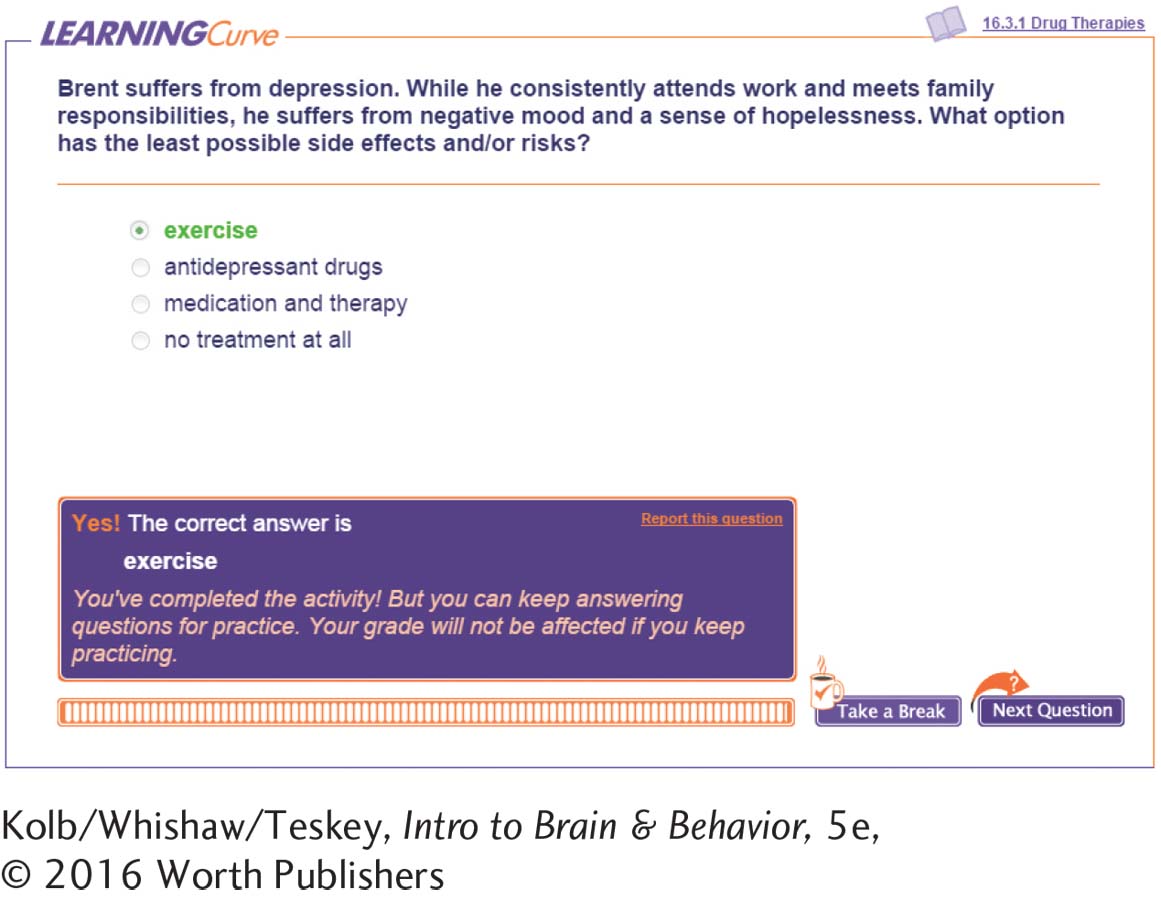MEDIA AND SUPPLEMENTS IIIIIII
An Introduction to Brain and Behavior, Fifth Edition, features a wide array of supplemental materials designed exclusively for students and teachers of the text. For more information about any of the items, please visit Worth Publishers’ catalog at www.macmillanhighered.com.
For Students
LaunchPad with LearningCurve Quizzing
A comprehensive Web resource for teaching and learning psychology

 to Accompany An Introduction to Brain and Behavior, Fifth Edition, can be previewed and purchased at http://www.macmillanhighered.com/launchpad/kolbintro5e.
to Accompany An Introduction to Brain and Behavior, Fifth Edition, can be previewed and purchased at http://www.macmillanhighered.com/launchpad/kolbintro5e.

An Introduction to Brain and Behavior, Fifth Edition, and  can be ordered together with
can be ordered together with
ISBN 10: 1-
ISBN-
LaunchPad combines Worth Publishers’ award-
LaunchPad for An Introduction to Brain and Behavior, Fifth Edition, includes the following resources:
THE LEARNINGCURVE quizzing system, written by Carolyn Ensley of Wilfrid Laurier University, is a new media component for this edition. LearningCurve combines adaptive question selection, immediate and valuable feedback, and a gamelike interface to engage students in a learning experience that is unique to them. Each LearningCurve quiz is fully integrated with other resources in LaunchPad through the Personalized Study Plan, so that students will be able to review with Worth’s extensive library of videos and activities. And state-
of- the- art question analysis reports allow instructors to track the progress of individual students as well as their class as a whole. SUMMATIVE QUIZZES, another new media component to this edition, were written by Linda Lockwood of the Metropolitan State University. Each quiz is written on the topics discussed throughout each chapter and features a variety of multiple-
choice questions presented to students randomly from question pools. Valuable to both student and instructor, the summative quizzes are a useful learning tool to propel students’ understanding of the information introduced in the book. AN INTERACTIVE E-
BOOK allows students to highlight, bookmark, and make notes, just as they would with a printed textbook. The search function and in-text glossary definitions make the text ready for the digital age. STUDENT VIDEO ACTIVITIES include engaging modules that instructors can easily assign for student assessment. Videos cover a variety of topics and are sure to spark discussion and encourage critical thinking.
THE SCIENTIFIC AMERICAN NEWSFEED delivers weekly articles, podcasts, and news briefs on the very latest developments in psychology from the first name in popular science journalism.
THE NEUROSCIENCE TOOL KIT is a powerful Web-
based tool for learning the core concepts of behavioral neuroscience— by witnessing them firsthand. These 30 interactive tutorials allow students to see the nervous system in action via dynamic illustrations, animations, and models that demystify the neural mechanisms behind behavior. Carefully crafted multiple- choice assessments make it easy to assign and assess each activity. Based on Worth Publishers’ groundbreaking CD- ROM, Foundations of Behavioral Neuroscience, the Neuroscience Tool Kit is a valuable accompaniment to any biopsychology course. Page xxviii

PSYCHOLOGY AND THE REAL WORLD: ESSAYS ILLUSTRATING FUNDAMENTAL CONTRIBUTIONS TO SOCIETY, SECOND EDITION is a superb collection of essays by major researchers describing their landmark studies. Published in association with the not-
for- profit FABBS Foundation, this engaging reader includes Bruce McEwen’s work on the neurobiology of stress and adaptation, Jeremy Wolfe’s look at the importance of visual search, Elizabeth Loftus’s reflections on her study of false memories, and Daniel Wegner’s study of thought suppression. A portion of the proceeds is donated to FABBS to support societies of cognitive, psychological, behavioral, and brain sciences.
For Instructors
REVISED! INSTRUCTOR’S RESOURCES This invaluable tool, for new and experienced instructors alike, was revised by Catherine Smith of Carleton University. It includes chapter-
Assessment Tools
Downloadable Diploma Computerized Test Bank Prepared and revised by Christopher Striemer of Grant MacEwan University, the Test Bank includes a battery of more than 1300 multiple-
Presentation
Illustration Slides and Lecture Slides Available for download from www.macmillanhighered.com, these slides can either be used as they are or customized to fit the needs of your course. There are two sets of slides for each chapter. The Illustration slides feature all the figures, photos, and tables. The Lecture slides, prepared and revised by Matthew Holahan of Carleton University, feature main points of the chapter with selected figures and illustrations.